
Little Turtle was a Sagamore (chief) of the Miami people, who became one of the most famous Native American military leaders. Historian Wiley Sword calls him "perhaps the most capable Indian leader then in the Northwest Territory," although he later signed several treaties ceding land, which caused him to lose his leader status during the battles which became a prelude to the War of 1812. In the 1790s, Mihšihkinaahkwa led a confederation of native warriors to several major victories against U.S. forces in the Northwest Indian Wars, sometimes called "Little Turtle's War", particularly St. Clair's defeat in 1791, wherein the confederation defeated General Arthur St. Clair, who lost 900 men in the most decisive loss by the U.S. Army against Native American forces.

The Miami are a Native American nation originally speaking one of the Algonquian languages. Among the peoples known as the Great Lakes tribes, they occupied territory that is now identified as north-central Indiana, southwest Michigan, and western Ohio. The Miami were historically made up of several prominent subgroups, including the Piankeshaw, Wea, Pepikokia, Kilatika, Mengakonkia, and Atchakangouen. In modern times, Miami is used more specifically to refer to the Atchakangouen. By 1846, most of the Miami had been forcefully displaced to Indian Territory. The Miami Tribe of Oklahoma are the federally recognized tribe of Miami Indians in the United States. The Miami Nation of Indiana, a nonprofit organization of self-identified descendants of Miamis who were exempted from removal, have unsuccessfully sought separate recognition.

Josiah Harmar was an officer in the United States Army during the American Revolutionary War and the Northwest Indian War. He was the senior officer in the Army for six years and seven months.

The Northwest Territory, also known as the Old Northwest and formally known as the Territory Northwest of the River Ohio, was formed from unorganized western territory of the United States after the American Revolution. Established in 1787 by the Congress of the Confederation through the Northwest Ordinance, it was the nation's first post-colonial organized incorporated territory.

The Battle of Fallen Timbers was the final battle of the Northwest Indian War, a struggle between Native American tribes affiliated with the Northwestern Confederacy and their British allies, against the nascent United States for control of the Northwest Territory. The battle took place amid trees toppled by a tornado near the Maumee River in northwestern Ohio at the site of the present-day city of Maumee, Ohio.
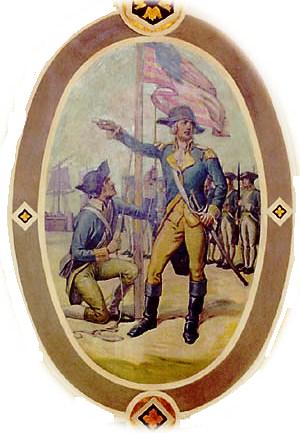
Jean-François Hamtramck (1756–1803) was a Canadian who served as an officer in the US Army during the American Revolutionary War and the Northwest Indian War. In the Revolution, he participated in the Invasion of Quebec, the Sullivan Expedition, and the Siege of Yorktown. In the history of United States expansion into the Northwest Territory, Hamtramck is connected to 18th century forts at modern Midwest cities such as Steubenville, Vincennes, Fort Wayne, and Detroit. The city of Hamtramck, Michigan is named for him.
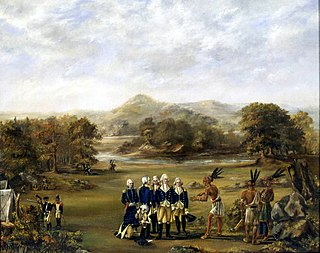
The Northwest Indian War (1785–1795), also known by other names, was an armed conflict for control of the Northwest Territory fought between the United States and a united group of Native American nations known today as the Northwestern Confederacy. The United States Army considers it the first of the American Indian Wars.
John Hardin was an American soldier, scout, and frontiersman. As a young man, he fought in Lord Dunmore's War, in which he was wounded, and gained a reputation as a marksman and "Indian killer." He served in the Continental Army during the American Revolutionary War, where he played a noteworthy role in the American victory at Saratoga in 1777. After the war, he moved to Kentucky, where he fought against Native Americans in the Northwest Indian War. In 1790, he led a detachment of Kentucky militia in a disastrous defeat known as "Hardin's Defeat." In 1792, he was killed while serving as an emissary to the Natives in the Northwest Territory.
Kekionga, also known as Kiskakon or Pacan's Village, was the capital of the Miami tribe. It was located at the confluence of the Saint Joseph and Saint Marys rivers to form the Maumee River on the western edge of the Great Black Swamp in present-day Indiana. Over their respective decades of influence from colonial times to after the American Revolution, French and Indian Wars, and the Northwest Indian Wars, the French, British and Americans all established trading posts and forts at the large village, originally known as Fort Miami, due to its key location on the portage connecting Lake Erie to the Wabash and Mississippi rivers. The European-American town of Fort Wayne, Indiana started as a settlement around the American Fort Wayne stockade after the War of 1812.

The Legion of the United States was a reorganization and extension of the United States Army from 1792 to 1796 under the command of Major General Anthony Wayne. It represented a political shift in the new United States, which had recently adopted the United States Constitution. The new Congressional and Executive branches authorized a standing army composed of professional soldiers rather than relying on state militias.
Fort Miami, originally called Fort St. Philippe or Fort des Miamis, were a pair of French built palisade forts established at Kekionga, the principal village of the Miami. These forts were situated where the St. Joseph River and St. Marys River merge to form the Maumee River in Northeastern Indiana, where present day Fort Wayne is located. The forts and their key location on this confluence allowed for a significant hold on New France by whomever was able to control the area, both militarily for its strategic location and economically as it served as a gateway and hotbed for lucrative trade markets such as fur. It therefore played a pivotal role in a number of conflicts including the French and Indian Wars, Pontiac's War, and the Northwest Indian War, while other battles occurred nearby including La Balme's Defeat and the Harmar campaign. The first construct was a small trading post built by Jean Baptiste Bissot, Sieur de Vincennes around 1706, while the first fortified fort was finished in 1722, and the second in 1750. It is the predecessor to the Fort Wayne.
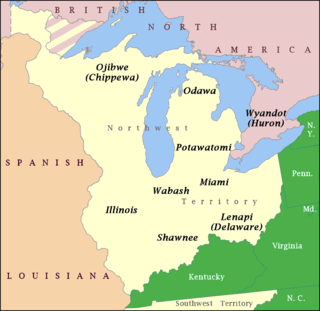
The Northwestern Confederacy, or Northwestern Indian Confederacy, was a loose confederacy of Native Americans in the Great Lakes region of the United States created after the American Revolutionary War. Formally, the confederacy referred to itself as the United Indian Nations, at their Confederate Council. It was known infrequently as the Miami Confederacy since many contemporaneous federal officials overestimated the influence and numerical strength of the Miami tribes based on the size of their principal city, Kekionga.
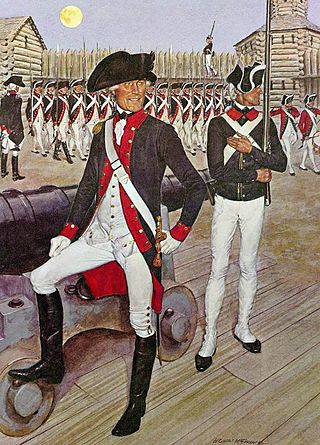
The First American Regiment was the first peacetime regular army infantry unit authorized by the Confederation Congress after the American Revolutionary War. Organized in August 1784, it served primarily on the early American frontier west of the Appalachian Mountains. In 1815, following the end of the War of 1812, it was consolidated with several other regiments to form the 3rd Infantry Regiment.

Pacanne was a leading Miami chief during the late 18th and early 19th centuries. Son of The Turtle (Aquenackqua), he was the brother of Tacumwah, who was the mother of Chief Jean Baptiste Richardville. Their family owned and controlled the Long Portage, an 8-mile strip of land between the Maumee and Wabash Rivers used by traders travelling between Canada and Louisiana. As such, they were one of the most influential families of Kekionga.

The Battle of Kenapacomaqua, also called the Battle of Old Town, was a raid in 1791 by United States forces under the command of Lieutenant Colonel James Wilkinson on the Miami (Wea) town of Kenapacomaqua on the Eel River, approximately six miles upstream from present-day Logansport, Indiana.

St. Clair's defeat, also known as the Battle of the Wabash, the Battle of Wabash River or the Battle of a Thousand Slain, was a battle fought on 4 November 1791 in the Northwest Territory of the United States. The U.S. Army faced the Western Confederacy of Native Americans, as part of the Northwest Indian War. It was "the most decisive defeat in the history of the American military" and its largest defeat ever by Native Americans.
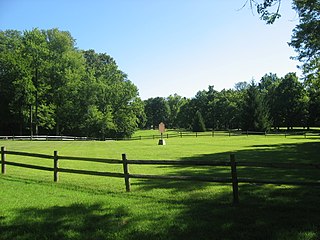
Fort St. Clair was a fort built during the Northwest Indian War near the modern town of Eaton, Preble County, Ohio. The site of the fort was listed on the National Register of Historic Places in 1970.
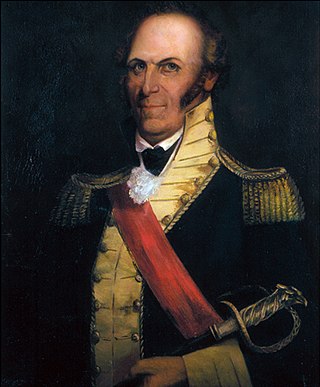
The Blackberry Campaign is the name given to a May 1791 expedition led by Charles Scott against Native Americans of the lower Wabash Valley, primarily Wea, Kickapoo, Miami, and Potawatomi. The intent of the campaign was to demonstrate the vulnerability of Native American villages in the Northwest Territory, to take captives who could be used for peace negotiations, and to keep the forces of the Western Confederacy off balance in preparation for a larger campaign led by Arthur St. Clair. The name Blackberry Campaign was given because soldiers stopped to pick berries to supplement their food supplies.
John Palsgrave Wyllys (1754-1790) was a United States Army officer from Connecticut. Wyllys was the son of George Wyllys and Mary Woodbridge, and the youngest brother of Samuel Wyllys. He graduated from Yale College with Nathan Hale.
Asa Hartshorne was a United States Army officer who died in 1794 during the Northwest Indian War. He was among the signers of the Treaty with the Six Nations and the Treaty with the Wyandot at Fort Harmar on January 9, 1789. Hartshorne became the namesake of a 1790 frontier skirmish near Maysville, Kentucky.


















